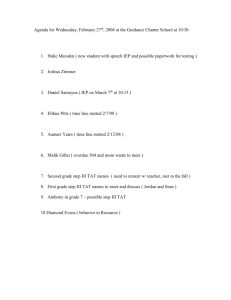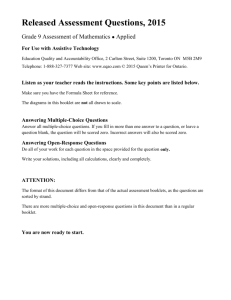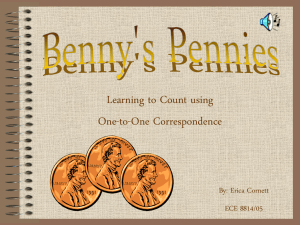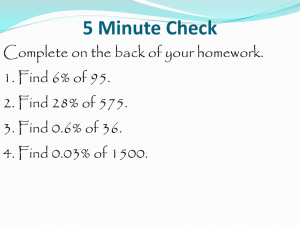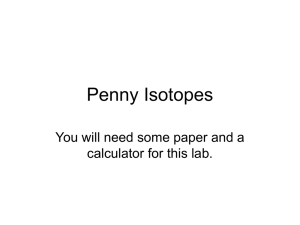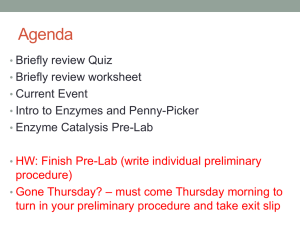Calculating Density - Experimental Skill and Investigation
advertisement
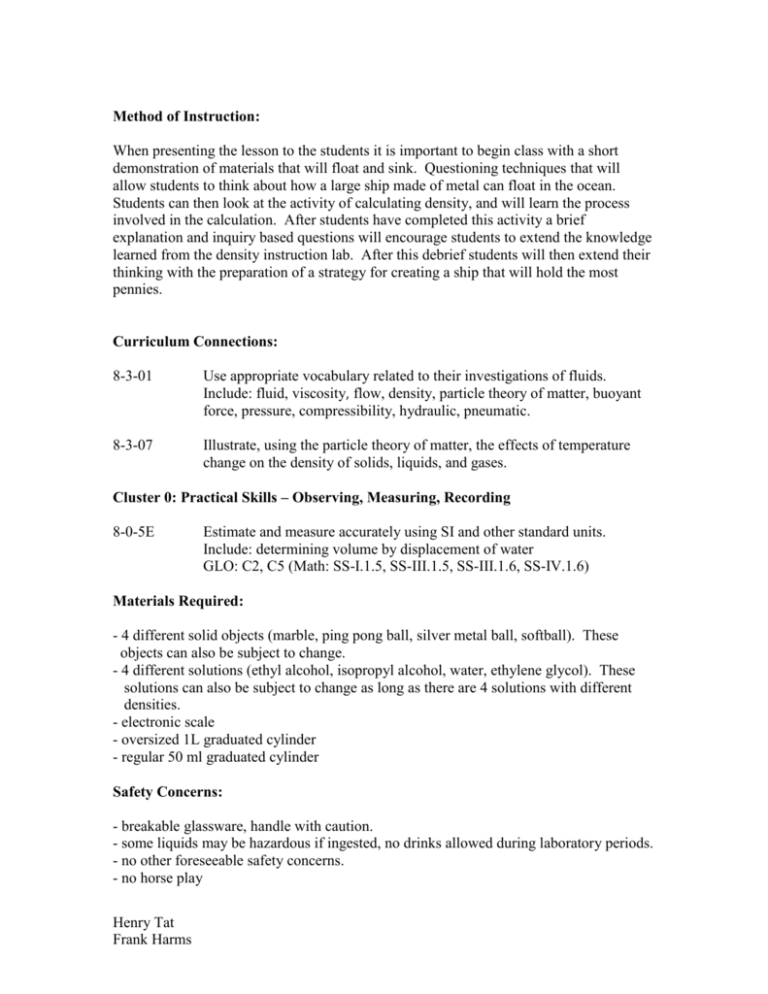
Method of Instruction: When presenting the lesson to the students it is important to begin class with a short demonstration of materials that will float and sink. Questioning techniques that will allow students to think about how a large ship made of metal can float in the ocean. Students can then look at the activity of calculating density, and will learn the process involved in the calculation. After students have completed this activity a brief explanation and inquiry based questions will encourage students to extend the knowledge learned from the density instruction lab. After this debrief students will then extend their thinking with the preparation of a strategy for creating a ship that will hold the most pennies. Curriculum Connections: 8-3-01 Use appropriate vocabulary related to their investigations of fluids. Include: fluid, viscosity, flow, density, particle theory of matter, buoyant force, pressure, compressibility, hydraulic, pneumatic. 8-3-07 Illustrate, using the particle theory of matter, the effects of temperature change on the density of solids, liquids, and gases. Cluster 0: Practical Skills – Observing, Measuring, Recording 8-0-5E Estimate and measure accurately using SI and other standard units. Include: determining volume by displacement of water GLO: C2, C5 (Math: SS-I.1.5, SS-III.1.5, SS-III.1.6, SS-IV.1.6) Materials Required: - 4 different solid objects (marble, ping pong ball, silver metal ball, softball). These objects can also be subject to change. - 4 different solutions (ethyl alcohol, isopropyl alcohol, water, ethylene glycol). These solutions can also be subject to change as long as there are 4 solutions with different densities. - electronic scale - oversized 1L graduated cylinder - regular 50 ml graduated cylinder Safety Concerns: - breakable glassware, handle with caution. - some liquids may be hazardous if ingested, no drinks allowed during laboratory periods. - no other foreseeable safety concerns. - no horse play Henry Tat Frank Harms Calculating Density Introduction: In this learning activity, students will demonstrate their laboratory skills in their investigation of the density of solids and liquids. It is common in everyday life for people to witness solid objects of different sizes and shapes that have different masses. This is due to the density of different materials. In some cases, you may see a small object that is very light in weight. While in other cases, a small object may also be very heavy in weight. In contrast to solid objects, different liquids with the same volume can have different masses. Density will affect the masses of all materials in the liquid, solid, and gas phases. Stage 1: How to Calculate Density of a solid object. 1. The formula to determine the density (d) of an object is equivalent to its mass (m) in grams, divided by the volume of the object (v), in milliliters, or d=m/v. In order to determine density we must determine the mass and volume 2. In order to gain an understanding of the process of calculating density we will work thru the density of four objects. To calculate mass you can use an electronic scale, alternatively we could use a balance. 3. Begin by plugging in the scale; students should then hit the reset/zero button. This will reset the scale to be at zero, thereby allowing the measurement to be calculated without having to be subtracted if there was an initial weight on the scale. 4. Record the mass of objects 1(small, heavy ball, ex. marble), 2(small light ball ex. Ping-pong ball), 3(Large, heavy ball, ex. Large silver metal ball) and 4(large light ball, ex. softball) in the chart below. 5. Now to find the volume of a solid object we can use displacement as a means of calculating volume. 6. Fill an oversized 1L graduated cylinder with a set amount 500ml of water and record below. 7. Place object into cylinder. Record volume in “Volume with object” below. (Remember to measure the bottom of the meniscus) 8. To find the total Volume displaced, subtract Initial Volume and Volume of Object. 9. To calculate Density divide the Mass in grams by the Volume displaced in milliliters. Henry Tat Frank Harms 10.Finally record whether the object floats or sinks. Mass(g) Initial Volume Total volume with Displacement object (A) (B) (C ) (C –B) Object 1 Object 2 Object 3 Object 4 What did you notice about the mass of the objects? What did you notice about the Density of the four objects? Henry Tat Frank Harms Density A / (C-B) Sink or Float Why did some objects float and some objects sink? Predict how would you calculate the density of a liquid? Part B: Further Inquiry into density of liquids. Density is the mass per unit of measure, especially per unit length, area, or volume. In the case of solids, some solid objects can have a low density (meaning light in weight) or a high density (meaning heavy in weight). We can conceptualize density using pennies in a jar. Let’s say we have 10 pennies in a 250 ml jar. This would be relatively light compared to 100 pennies in a 250 ml jar. In the case of the jar with 10 pennies, this would have a relatively low density compared to the high density of a jar filled with 100 pennies. If we called the pennies particles, we could say that objects with many particles per unit of measure have a higher density than objects with fewer particles per unit of measure. The same goes for the density of liquids. Liquids that contain many particles of a particular substance will have a higher density than liquids that contain fewer particles of a substance. In the following activity, working in pairs, we will try to construct a boat that will out float all other students’ boats. Using the properties we learned about density above will allow you to create the most effective design to hold the maximum amount of pennies. During the following investigation you will focus on the factors that will allow your boat to hold the most pennies and still stay afloat. In writing out your demonstration use the guide provided below, it will help you to organize your design. Henry Tat Frank Harms 1. Consider the Components of the investigation. What could you change in order to make your ship a better floater? In each of the following bubbles write in the parts of the experiment that effect change in the system. Below each bubble write ways in which each could be changed to produce a different result. 2. Suggest three questions you wish to investigate with reference to the changes stated above. Or what questions would help us to find the best floater? a. b. c. 3. Predict a solution for each question, from what you have observed in the demonstration and the explanation above, what do you think is going to happen if you conducted investigations of each of the questions above? Which would you predict would increase the buoyancy of the boat the best? a. b. c. Henry Tat Frank Harms 4. Now choose one of your questions above to investigate. Choose one factor that you wish to change in order to create the supreme floating machine. 5. Describe what you are going to change, what you are going to keep the same and how you will measure your results. Keep Same Change? What to measure? How to measure it? 6. What materials do you need to conduct the experiment? Henry Tat Frank Harms 7. Use the above to design as a procedure for your investigation. What are the steps to help you find an answer to your question? 8. Record your data in the box below. It maybe useful to make a chart in the box below with a ruler and pencil. 9. Conclusions: a. What does the data collected appear to suggest is the answer to your question? Henry Tat Frank Harms b. How does your conclusion above relate to your prediction of the answer to your question? c. What improvements can you make to your boat in order to carry more pennies than your previous design? d. Re-design your boat implementing changes from above and test against other students. You may draw a design in the space below and record your results against other students in the chart below. Student Name Henry Tat Frank Harms Number of Pennies Student Name Number of Pennies Student Name Number of Pennies

